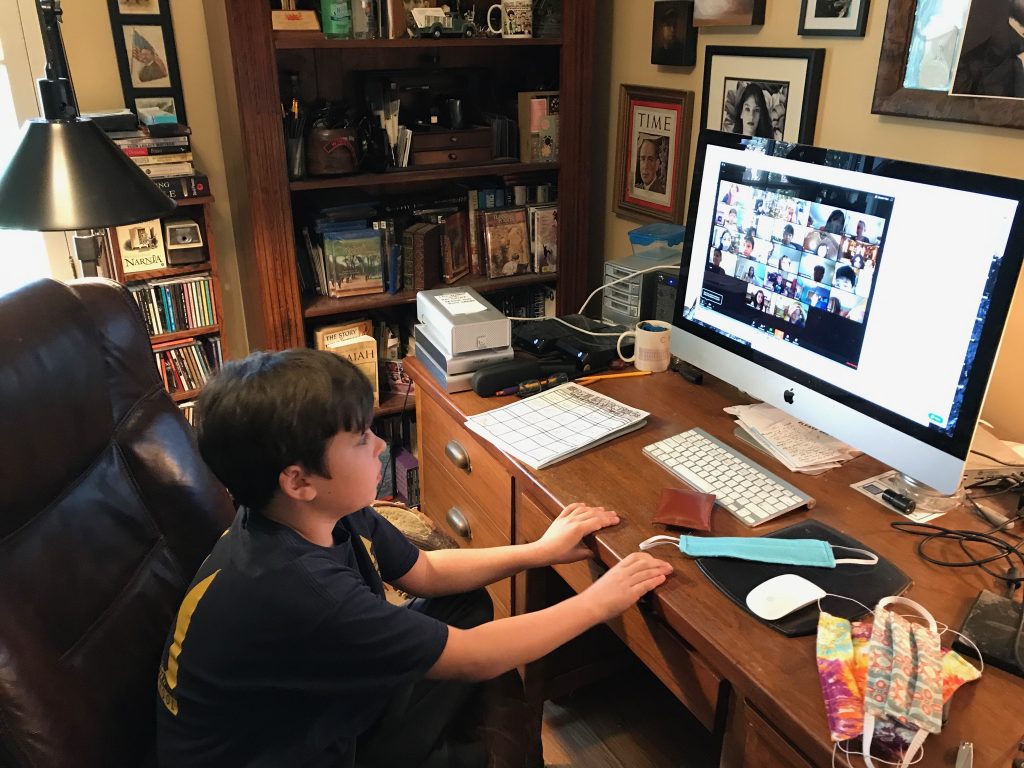
Fifth grade student Avril Coba shows off her baked Roman bread.
By Lori BODNAR, intern
Most local schools have been “remote learning” for about a month now due to COVID-19 social distancing safer-at-home directives. Teachers, parents and students have risen to the challenge. Many schools are finding various platforms to use for online learning to engage students and keep them connected to their teachers and peers so they can continue with their studies. School districts have also worked hard to ensure that students have access to technology for online learning, such as laptops and internet hotspots.
Teachers have used several methods to communicate with and teach students online. Many teachers use Google Classroom, Google Meet, Zoom and Flipgrid to communicate with students, explain assignments, answer student questions and review student’s work.
Jennifer Garrubba is a third-grade teacher at Mountain Avenue Elementary School who is meeting the COVID-19 teaching challenges.

“I chose Google Classroom to communicate daily with the students in my class about their lessons and activities. We had already been using Google Classroom, so the students were familiar with it, which really helped!” said Garrubba. “I have found that the students need interaction where they can hear and see not only the teacher, but each other. Therefore, I have included Flipgrid and Zoom in our distance learning as well. I want to thank the many parents who have expressed their appreciation and support as we embarked on something so unexpected – distance learning.”
Amber McLeod, an AP human geography teacher at Crescenta Valley High School said, “I use the online AP Classroom program to assign my students practice assessments in preparation for the AP exam. Additionally, I assign work on Google Classroom. I host a weekly Zoom session with each of my classes to touch base and have discussions about the topic that we are studying.”
This year, due to the outbreak of COVID-19 and social distancing requirements, all AP exams will be taken online, open note for the first time with all students worldwide taking their tests at the exact same time. For most students in the U.S., their tests will be given during daylight hours with three different AP tests per day but some students abroad will be taking their AP exams in the middle of the night. The online exams are significantly shorter than usual, and only contain the written portion in 45 minutes, instead of the usual three hours. AP testing online begins on Monday, May 11 with physics and continues until Friday, May 22 with statistics, Spanish, and government. Some of the exam dates/times changed from their original paper-and-pencil times, so any student taking an AP test should double-check their time to test online.
For the SAT, both May and June test dates were canceled due to COVID-19. For the ACT, the April test was canceled but the June 13 test is still scheduled for now.
For students learning a foreign language, it is important to have the opportunity to speak and hear the language, so remote learning can be a challenge. Sandra Der Mesropian is a Spanish teacher at Crescenta Valley High School. Der Mesropian teaches Spanish 5-6, AP Spanish Language and Culture (7-8), and AP Spanish Literature and Culture (9-10).
“I try to replicate some of the personalized discussions, ask about their weekends, just practice expressing themselves in Spanish,” said Der Mesropian. “I use Google Classroom to communicate, post resources, post notes and activities, Yabla language immersion for listening, YouTube Spanish language videos, and Google Meets three times a week.”
There are positives and negatives to teaching online.
“Remote teaching is a challenge because it lacks the face-to-face interaction that we get in the classroom,” said Garrubba. “Everything needs to be communicated through technology. Fortunately, the students are technologically savvy. It also helps that students are eager to continue their studies. A positive of remote teaching is that the students and I are learning new things in technology. We have also found a new appreciation for paper and pencils! A negative of remote teaching is that I miss teaching in person and being able to walk around the classroom to check the students’ work. The students miss interacting with the teacher and their classmates in a classroom setting.”
Der Mesropian added, “Remote learning has been challenging: assessing the technology, trying to figure out the best ways to present the material so students have access to it. I am happy and motivated by the participation of the students. They have risen to the challenge and are following through, participating in class and completing tasks. The positives for some of the students, as shared in class discussions, is a little bit more freedom with time management. The disadvantage is the connections that are created in a classroom setting. As a teacher, it is difficult to gauge the understanding of the material, since I’m unable to see the faces/eyes of the students so I can’t see the doubt, confusion or read the cues of when they may need more elaboration because many do not have the camera on.
“I’m proud of the students. Many have been responsible, consistent and disciplined. I miss seeing them in class and interacting as a learning community in person. I prefer that. It is friendlier. I hope to be back in school in the fall.”
Getting used to the new way of teaching has had some challenges.
“The first two weeks of remote teaching were a bit rough getting adjusted and learning new online tools, but now things are flowing nicely,” said McLeod. “I like that I get to do my work snuggling next to my doggie. Other than that, I really dislike remote teaching. So much of the magic of teaching happens in the classroom, face-to-face. I love seeing my students in person everyday and making meaningful connections. It is more difficult now. My heart goes out to the seniors who are missing important milestone events.”
With remote learning, there are many ways that students can get distracted. Many teachers have offered poignant advice for students.
“I would advise my students to check Google Classroom every morning,” said Garrubba.
“Ask questions in class discussions or use the chat to ask questions, view the resources provided as supplemental, read your notes, and find a classmate with whom you can review and discuss,” added Der Mesropian.
McLeod also had advice for her students who are remote learning.
“The best advice I have for students is to create a schedule,” she said. “Otherwise it’s easy to slide into binge watching TV or playing games or going on social media on the phone all day. Don’t let the day get away from you. It seems fun to goof off but, over time, it will feel empty and might lead to anxiety and depression. Try to fill some of your day with meaningful work and also exercise.”
Students have also been adjusting to remote learning at home. In addition to figuring schedules and capitalizing on available information, most are dealing with the social injury of the pandemic: missing their classmates and friends.
“One good thing about remote learning is that I get a lot more sleep and I feel healthier,” said Mary Ajemyan, an 11th grader at Crescenta Valley High School. “One negative of remote learning is that my work ethic has gotten pretty bad and I end up spending hours not doing anything. AP exam review is a challenge with remote learning. Without physically seeing my AP teachers, it’s harder to understand the review and exam material. The schoolwork is a lot less. I miss going to school even though I got a lot less sleep in regular school.”
Julianna Cheney, another junior from CVHS, said, “The positives of remote learning are that there is less amount of work and the instructional videos can be paused and repeated to hear information [that I missed]. The negatives are trying to learn the material on my own and the inability to see others. I’ve had a hard time staying at home, not being able to see anyone. Sure, we can call and text but it’s definitely not the same.”
In addition to high school students, elementary school students also miss their friends and classrooms. Avril Coba is a fifth grader in Christina Haydt’s class at Mountain Avenue Elementary School.
“It is nice to take breaks when I want, and to be with my family all the time,” said Avril. “The lockdown has also let me try new things that I never had time to do before. It is disappointing to not see my friends every day. I also think school is easier when I have a teacher helping me along the way. But everything is new and a bit confusing. [Before] I simply asked my teachers what I should do, but over time I am getting the hang of it. It feels like there is more schoolwork, even though there is less. It is probably because at school everything is spread out, but online it is all packed in.
“My dad is working from home, and my mom helps manage the CVHS Academy of Science and Medicine at home as well. We have no issues sharing technology since there are plenty of electronics. We simply go with the flow and do our best to stay healthy.”
Parents are also adjusting to working at home and spending more time with their kids.
“We have water, electricity, and gas. We have a roof over our head. I am working in the IT Dept. and work at home,” said Kavita Singh, mother of third grade student Alisha and first grade student Alina. “It’s been busy for us but it has been hard to supervise the kids’ education from home. The positive is spending time with family. It has been good to be with family. Schools are doing an amazing job and the teachers have their tasks defined. Alina is not as busy so she will usually finish a week worth [of school work] in one day. They play games. They have been doing dance workouts on YouTube and exercising online to stay active. They learned how to make coffee and oatmeal. They have cleaned up the house. They do their own laundry now. [Teacher] Mrs. Young is doing a great job and putting in a lot of hard work and we appreciate that.”
Singh added that the girls were given Chromebooks by Mountain Avenue Elementary School, where they attend, to work on at home. Since the Singh household has just one laptop it would have been difficult for the girls to finish their schoolwork.
During spring break, which began on March 16, the GUSD school district polled parents and families about technology to see who needed Chromebooks, then distributed the school laptops to families who requested one. The district is also providing school meals to students in need and has changed its grading policies during the remote schooling period. For more information, visit www.gusd.net.
But being at home also provides opportunities for new experiences – albeit virtually.
“I am a member of the British Museum in London,” said Avril. “I do activities that [are] put online. Last weekend I [made] Roman bread from an old Roman recipe. My photo got published in the Young Members of the British Museum magazine.”
Schools are currently scheduled to remain in a remote learning mode until June 10, the last day of school for GUSD for 2019-20.
